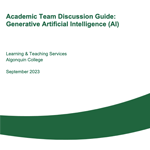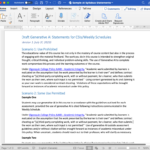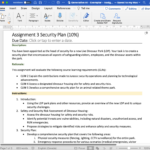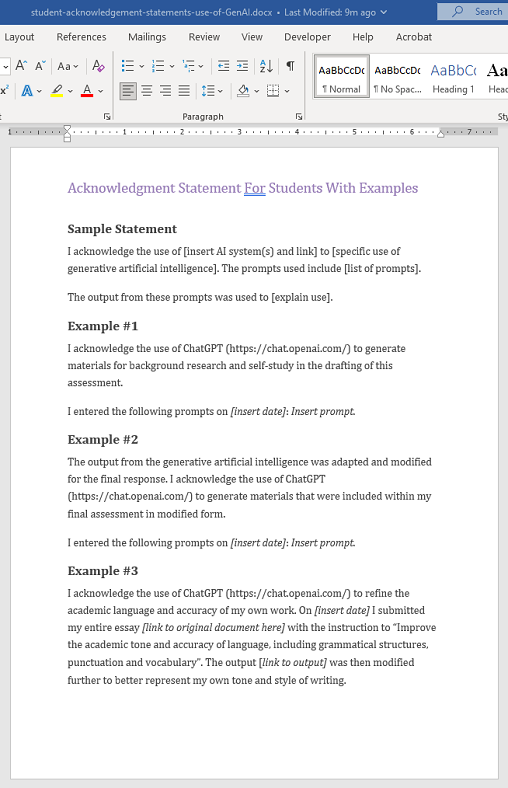Generative AI: Faculty Resources
Academic Team Discussion Guide

This discussion guide has been created to support academic teams in considering how Generative AI can and will be used in fields of study, and to assist them in determining ways of best responding to the rapid emergence of this technology.
Weekly Schedule/Syllabus Sample Statements

This document includes different scenario statements to include in your Weekly Schedule/Syllabus to outline the use of generative AI tools within the classroom
Instructions/Grading Tool Exemplar

An example generative AI assessment exemplar that includes instructions and a rubric
Download Grading Tool Exemplar
New! Student Statements: Acknowledgement of AI Use

Sample statements that your students can use to declare how they used Generative AI to prepare their assignment.
Download Acknowledgement Statements
Plan Your Approach to Generative AI Use in Your Course
According to a recent poll by KPMG (2023), 1 in 5 Canadians are using generative AI to help them with their work or studies. We know that students are using ChatGPT and other tools within their courses – and will continue to do so.
How can you deal with its use in your course? Some things to consider include:
1. Identifying True Instances of ChatGPT Use Can Be Difficult
Existing AI detection tools, such as Turnitin’s, are imperfect. Students can apply various techniques to avoid detection. Detectors will also produce false positives – which can disproportionately identify the work of students whose first language as English as being AI-generated writing (Coley, 2023).
2. Learning With and About AI is Beneficial for Students
Purposeful integration of AI into learning activities and assessments can prepare students for a work world in which AI tools are ubiquitous. Understanding how generative AI tools work and what their strengths and limitations will likely serve graduates well in their careers. Instead of focusing on rote learning and recall of facts, activities with generative AI may support more critical thinking, problem solving, creativity, and reflection. Furthermore, use of generative AI may reduce barriers to learning for neurodivergent students.
Review Your Learning Activities and Assessments
After trying ChatGPT, you may decide to include some opportunities for students to interact with ChatGPT. This may include:
- Students asking questions using ChatGPT, then doing some fact checking and critical reflection on the output.
- Students brainstorming discussion or debate questions related to a topic.
- Students preparing an outline or a first draft of a written assignment.
Be sure to introduce the use of ChatGPT in class by discussing the opportunities and limitations of ChatGPT to set the stage for critical analysis of the results.
Can ChatGPT Do My Assessments?
Upon reviewing the activities assessments in your course, you may find that ChatGPT can complete most of the work for students. Consider these ideas for modifying your assessments.
Evaluate process as well as final product
- Include assignment elements in which students share and reflect on their work process.
- Have students submit artifacts (e.g. assignment components), in addition to a final product, that demonstrates their work process.
- Include grading criteria (e.g. within rubrics) that grade for development of understanding and skill. You can include appropriate use and citation of ChatGPT within your grading rubric.
Use in-class time for students to demonstrate skills and understanding
- A flipped classroom model has students review content and complete review activities outside of class, then practice their application in class.
- Consider using classes for real-time, observable activities such as debates, discussion, group and independent work, and role plays.
Allow submission of multimedia assignments
- Students can submit non-written assignments such as a video project (in which students share prepared script, edits, and final produced video), an audio or video interviews, or a video role play.
- As an assignment component, students can submit a video reflection of their learning process.
Encourage students to relate to personal experiences
- Students can use their own opinions, reflections, and personal experiences as context for completing the assignment.
Contextualize the assignment to specific elements
- Students can base their assignment on unique course experiences (e.g. guest speakers, class discussions, customized case studies not readily found on the Internet)
- Responding to very current events or recent developments within a particular industry may be more challenging for Generative AI.
Adapted from “Strategies for Creating “Generative AI-Resistant Assessments”, University of Wisconsin – Green Bay’s Center for the Advancement of Teaching and Learning
Academic Integrity and Assessments
It is important to plan how to adapt your assessments to address the use of Generative AI tools in your course.
Review our Academic Integrity section for ideas and guidelines related to assignment redesign, use of AI Detectors, citing the use of AI, and setting expectations for AI use in your course
Visit Academic Integrity
References
KPMG (2023). Canada Generative AI Adoption Index. https://kpmg.com/ca/en/home/media/press-releases/2023/06/one-in-five-canadians-using-generative-ai-platforms.html
University of Wisconsin – Green Bay (2023, May 2). Strategies for Creating “Generative AI-Resistant Assessments. https://blog.uwgb.edu/catl/strategies-for-creating-generative-ai-resistant-assessments/